
32 proven ways to increase your clients as a freelancer

Before the Covid-19 outbreak, the world of employment was rapidly changing. According to the Association of Independent Professionals and the Self-Employed (IPSE), in the UK alone, 4.8 million people work in the self-employed sector. Out of this, 42% are freelancers, which comprises 6% of the total UK workforce.
And while Covid-19 has brought more change and challenge to the job market, there are still opportunities for skilled and talented professionals who offer flexibility, value and experience. The market may be in recovery mode, but companies are still growing, developing new products and competing for new customers — and they need your help.
This guide is all about helping you find clients. Pick and choose the techniques that make sense for you, your clients and the business you want to build. Start with methods that have the potential to bring you the most clients with the least effort. But be prepared to test a few different approaches until you find the tactics that work for you.
Table of Contents
- First – a word on Covid-19
- Methods that use what you’ve already got
- Methods that take a few hours a week
- Methods for long-term investment
- Expert insights
- Wrapping up
Freelancing and Covid-19
The world is in a state of flux. Succeeding as a freelancer in 2020 may partly depend on your ability to navigate and adapt to this changing world. The pandemic has devastated many industries, but also created opportunities as businesses scramble to work from home, sell their products online and strengthen relationships with customers they can no longer see or hear.
As we emerge from lockdown, new opportunities will blossom as other streams of work dry up. Keep one eye on the horizon and be prepared to adapt your service offering, your pitch and your structure as the world establishes a new normal.
Is 2020 a bad year to begin freelancing? There’s no definitive answer to that question. On one hand, the economy is in for a shock as businesses struggle to return to profitability after lockdown. On the other hand, the government is working hard to absorb the shock and boost the economy. And while there may be fewer businesses hiring freelancers, there are also fewer freelancers available for work, with some retiring, some occupied with home-schooling, and plenty looking for the relative security of regular employment. An optimist might argue that now is a better time to start freelancing.
Methods that use what you’ve already got
1. Know your ideal client inside out
First things first, create a comprehensive description of your ideal client. Get as specific as you can. Are they large corporations or small businesses? Which sectors do they operate in? What specific areas of the selected industry are they involved with? What are their biggest challenges?
Build each profile out into a documented buyer persona, as illustrated by this example from Alexa:
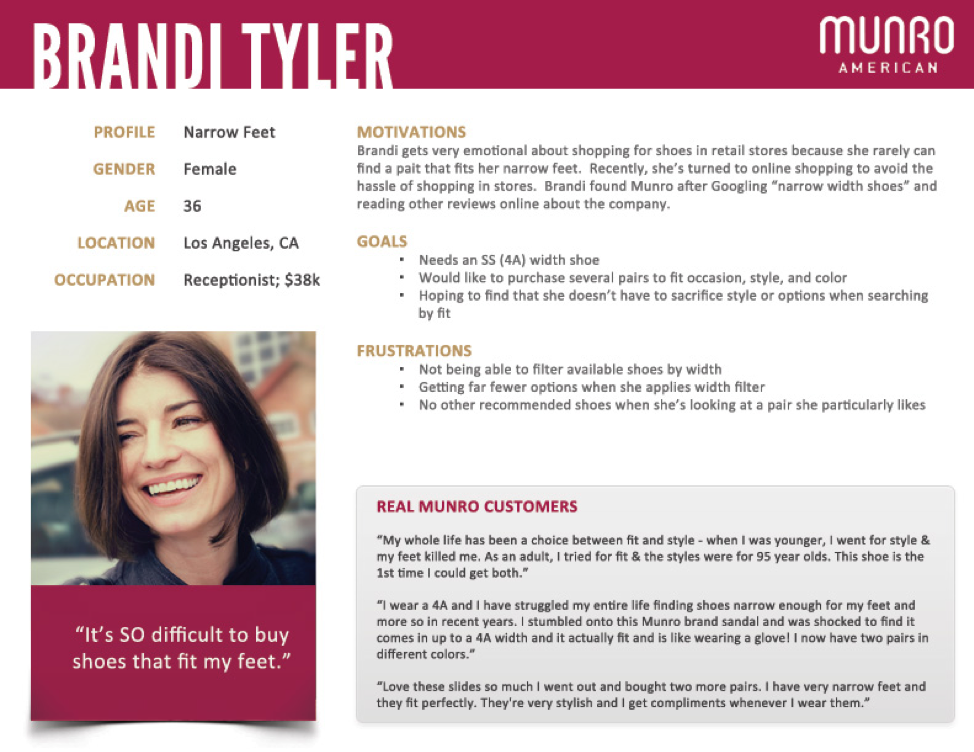
For instance, if you’re a digital marketing firm targeting IT professionals, you might select several industries that you’re already familiar with. Create buyer personas to profile your ideal client in each of your target industries to fully understand their needs.
2. Define a clear UVP
To stand out from the competition, you need to show how you’re different. For example, if you’re a WordPress developer, you might differentiate yourself by:
- Serving a specific market (e.g. drop-shipping companies)
- Building proprietary software for a specific problem
- Offering add-on services such as technical monitoring
Whatever it is, make your unique value proposition (UVP) clear across all your marketing and communications. This way, you’re not just a WordPress developer, but an expert who offers clearly-defined value.
In the example below, Kimberly Blaker has a section on her website for her “parenting and family life writing services”:
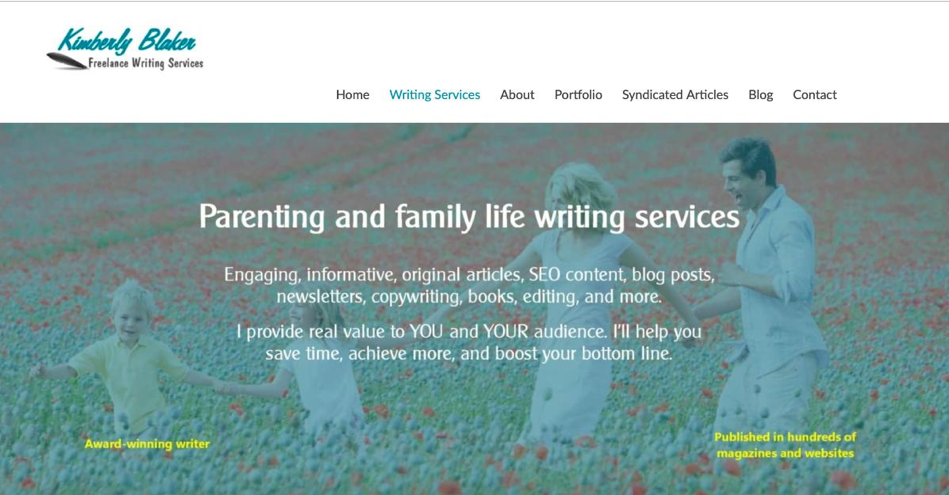
When businesses in this industry look for Kimberly’s services, her messaging is sure to get their attention.
3. Update and optimise your website
Your website acts as the hub for your social media presence, portfolio and case studies. Both your site design and content should look and feel professional and consistent with your image. Remember to align them to your UVP (unique value proposition) and highlight the results you deliver for clients.
Include photos and videos of your activities and achievements. Make your personality shine. Images of awards and testimonials from clients should be proudly posted as well.
Claudine O’Sullivan, an award-winning illustrator and professional artist, reminds her audience about the importance of including personal projects:
“For me, personal projects dictate the kind of work I get commissioned for. In a visual industry, it’s vital that your portfolio reflects the work you want to get, not just what you’ve done so far.”
Claudine O’Sullivan, artist
4. Tap into your network
Your primary network consists of close friends, relatives, colleagues and peers in your industry or profession. You’ve built trust over time, and they’re confident in your expertise and knowledge on a certain market or topic.
It’s highly likely that they have their own professional network. A network of people they can refer you to.
When looking for referrals, this is the best place to start. Ask them if they know anyone who needs what you’re offering. Tell them what you’ve built or what you do, and ask them to suggest anyone they know who may be interested.
But be careful not to be too pushy. Your network is valuable, and it’s not worth burning relationships by pestering them.
5. Join networking events
Networking events allow you to build connections with fellow entrepreneurs. Start with events close to home around topics relevant to your services. Remember that the best networking is rarely described as ‘networking’ — but may be called a meet-up, huddle, conference, workshop, talk or a demo. As well as looking for events attended by your commercial peers, look for events that will attract your potential customers. Even if you don’t manage to pick up business, you will learn a lot about your target audience and their industry or profession.
Claudine O’Sullivan, recommends the following:
“Connect with people. Not just online, get out and meet people, there’s so much more to gain from face to face than to bulk emails. I’m not a naturally confident or outgoing person, but especially when starting, I went to as many events as possible.” – Claudine O’Sullivan, artist
Look for events that bring you closer to your peers and potential clients. This might be things like virtual quizzes, online networking, Facebook Live sessions, Twitter chats or webinars. Remember that peers are much more than competitors — they can also be great sources of leads and support.
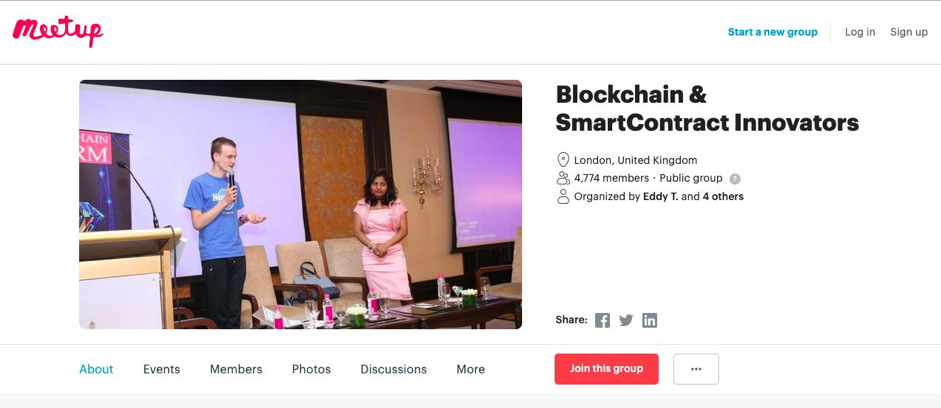
6. Reach out to existing clients for referrals
Speaking of referrals, when was the last time you asked an existing client for one? While it’s good to reach out to family, friends and peers, your clients likely know other potential clients who are just like them.
Inspiring word-of-mouth for your services doesn’t require much effort. All you need to do is send an email when the time is right. This could be when you receive positive feedback, or after a project has been wrapped up.
You can incentivise your referrals by rewarding customers for every new customer they send your way. Tools like ReferralCandy make this possible without any technical knowledge:

When reaching out to anyone, make sure you have permission to do so in order to remain GDPR compliant.
7. Upsell and cross-sell to current clients
Upselling and cross-selling are two simple ways to acquire new business from existing clients.
You will need to be sensitive to the fact that your clients may be facing additional pressures created by Covid-19, and they may not have the time or the budget to start new projects. But if you have products or services that can help them overcome these challenges, then they may be delighted to hear from you.
When looking to sell additional services to your clients, try the following approach:
- When you talk with your client, ask them about the challenges they currently face in reaching their goals
- Listen to what they say and dig deeper into their responses
- Offer your services as an additional value-add to solve specific pain points
For example, if you’re a landscape designer, you can offer garden maintenance for your client’s new garden after it has been completed. Whatever it is, make sure it alleviates a problem they have. This is how you make your upsell relevant to existing clients.
8. Create a project or package for your previous clients
Similar to the above, reach out to past clients to see if there are new projects you can help them with. Alternatively, you can create new service packages and outline the benefits to past clients.
For example, if you’re a freelance writer and a client doesn’t have an e-Book published on their site as a lead magnet, ask for a quick meeting to explain the benefits. Send a proposal after the meeting to show you’re the most suitable person for this task (since you’re already familiar with their business).
9. Ask clients for public reviews and testimonials
If your site has the functionality, ask your former clients to write an honest review about your services. They are also welcome to do this on your Google business listing. While it’s against Google’s guidelines to ask for reviews, they can do so of their own will:

Reviews and testimonials increase your credibility to prospective clients, as they have a chance to see how you add value to people just like them.
10. Add your name to professional directories
Directories are another useful place to be featured. And even if they don’t bring a flurry of leads, they may support your search engine optimisation efforts by providing another link to your website.
Some directories require payment, so choose carefully, but you should be able to find some directories that are free to join. Directories are occasionally dedicated to certain professions, or freelancers, and others may be restricted to people in certain communities, specialisms or locations.
You can find suitable directories with a Google search, or by asking fellow freelancers.
Methods that take a few hours a week
11. Use job boards to find companies in need of your services
If businesses are hiring for a relevant role in your industry, it’s a good sign that they’ll be interested in what you have to offer:

For example, if you offer product design services and see a company hiring for a “Head of Product” role, it’s likely there’s an opportunity here. You could also offer your services as a contractor until they find someone suitable for a full-time position.
Use job aggregators like Indeed.com to uncover these businesses. If they include their information (i.e. company name), enter it on LinkedIn and find the relevant person to reach out to.
12. Contribute to discussions on social media
Comment and respond to conversations on social media in an authentic manner. People love to interact with peers who add value to discussions, especially on sites like LinkedIn and Twitter.
Providing advice or recommendations demonstrates your expertise in your chosen field. This may lead to enquiries and, at the very least, can lead to invaluable lifelong connections.
Look for groups, hashtags and live chats so you can engage with your professional community effectively.
13. Sell your services on gig economy sites
Popular gig sites like Upwork and Fiverr can be a great way to get new freelance clients, as these sites act like job boards, but most often on a by-project basis.
It may take some time until you land a lucrative job, but it’s still worth building a presence on these sites in order to attract them. Furthermore, brands and employers are able to search for freelancers for new jobs they post. You can attract these brands by getting reviews for small jobs first.
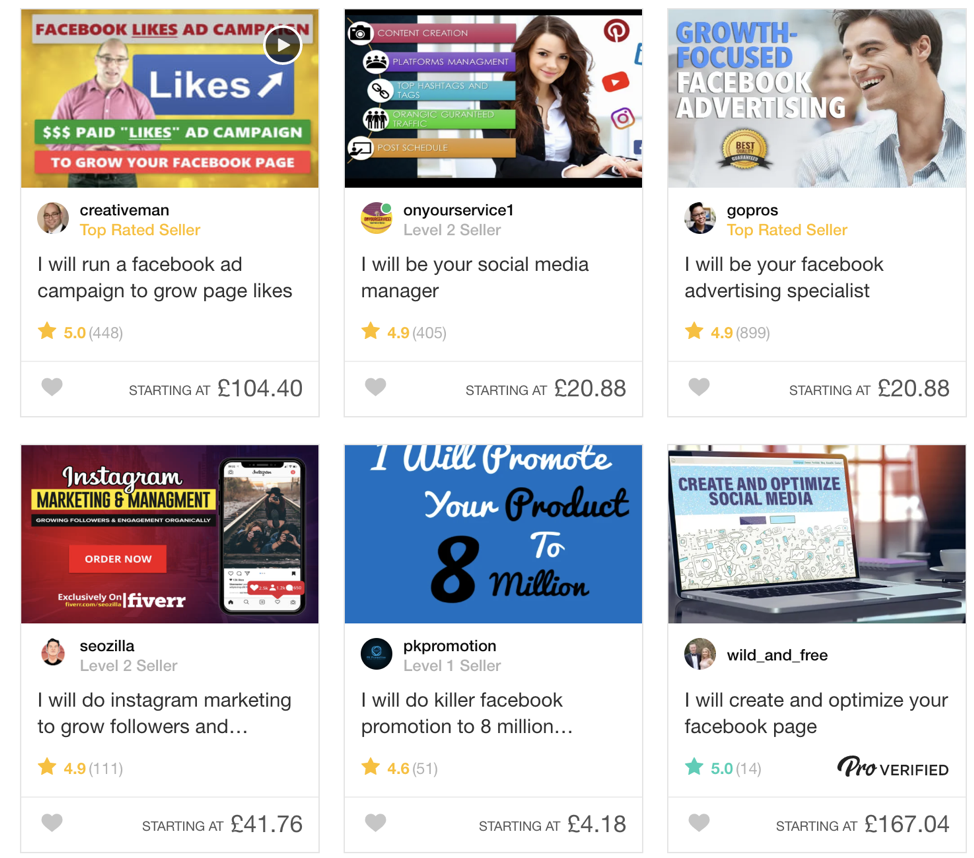
Many freelancers use these platforms as a way to reach out to new clients that wouldn’t have been possible to reach via other avenues. Wherever you stand with these services, they’re well worth testing. However, if you find that the quality and quantity of work doesn’t fit with your business plan, move swiftly on.
14. Utilise Slack and Reddit communities
More than just a communication platform for teams, there are hundreds of communities who have used Slack as a platform to bring people together. Reddit is also full of communities beyond funny memes. You can browse a long list of professional and niche online communities on LikeMindedHub.com.
There are communities out there on a range of topics, from real estate to cryptocurrency. You can get involved in these communities, even if you’re not yet an expert on those topics. Add value by sharing your own experiences on certain issues, and answer questions where you can lend your expertise.
15. Join a co-working space
In normal times, co-working spaces are brilliant places to work and get connected to a new circle of friends and potential colleagues.
And these qualities will certainly resume as soon as coworking spaces like WeWork, Work.Life, Workbar and LiquidSpace reopen for general co-working.
Building connections takes time though, so be prepared to make co-working a regular part of your routine. You should also take advantage of any social occasions, workshops or presentations hosted within your co-working space, as these are a great way to get to know your fellow co-workers.
16. Add value by answering questions on Quora
Quora is a popular Q&A site used by people to find in-depth answers to their burning questions. It’s also a strong community of experts looking to provide the answers, which you can get involved in.

Contributing to Quora questions with in-depth posts also helps with your content marketing efforts. By including links back to relevant blog posts and pages on your website, you can tap into a new source of traffic and potential leads.
17. Search for your ideal client’s pain-points on Twitter
Search for relevant pain points on Twitter through various hashtags. For example, if you’re a UX designer, search for #ux and identify questions or complaints that you can address. Monitor conversations between competitors and their clients to get a sense of any opportunities that arise.
To simplify these tasks, use listening tools like BuzzSumo and Mention.

18. Be helpful in all your interactions
Be a kind and helpful person in every interaction. This will elevate your personal brand as a pleasant person that’s always willing to go the extra mile – for clients and peers alike.
Helping people, even if they don’t seem like the ideal client, builds goodwill within your industry.
Remember that as a solo-entrepreneur, you are your own brand. How you act and what you give out to the world will come back to you.
Methods for long-term investment
19. Partner up with an agency
Introduce yourself to agencies that work with freelancers. You can start with the top 10 agencies in your area or city, such as advertising and digital marketing agencies.
Impress them with a strong portfolio, case studies and testimonials. Share your experiences working with similar agencies if you’ve already done so. Offer to partner with them by offering additional services to their existing clients. Agencies may wish to ‘white-label’ your services, so that you appear to be part of their team, and their clients get a seamless experience.
20. Set up an affiliate program
Affiliate programs allow customers and other businesses to refer new customers in exchange for a reward or monetary commission. They work differently than referrals, in that affiliates are expected to actively promote your products and brand.
When launching an affiliate program, announce it via an email and include a landing page to allow people to sign up on your website. Be clear about the benefits and what the commission is for new customers they refer.
Commissions can be a one-time reward or recurring for as long as a customer does business with you. For example, let’s say you offer a 20% affiliate commission on a product that costs £150. This means affiliates will earn £30 for every new customer they refer, which can add up if they’re actively promoting you.
The amount you decide to pay affiliates depends on your service pricing, product margin and customer lifetime value (LTV). If, for example, a product costs £20 but you know the LTV for a customer is £1,230 at a 50% margin (£615), then you could justify rewarding your affiliates with £20 from the initial sale.
Use a tool like AffiliateWP to build these programs straight into your website. If your website doesn’t run on WordPress, there are many alternatives available.
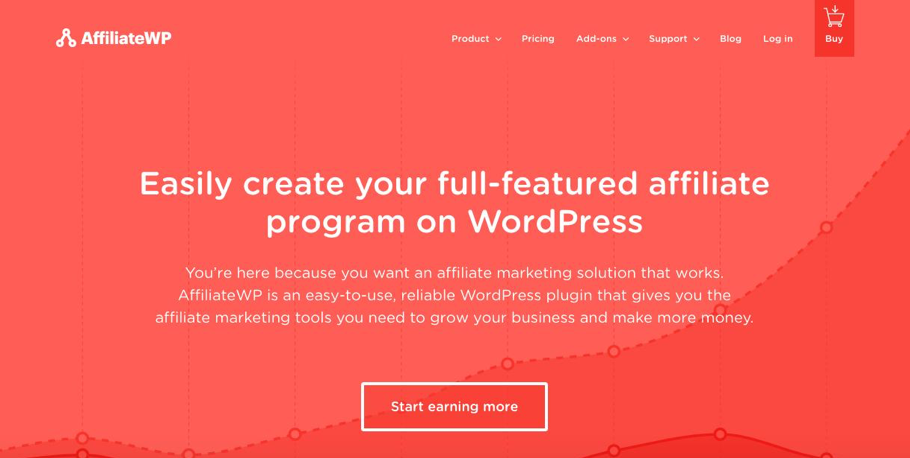
21. Write killer case studies to prove your results
According to a report by TrustRadius, 50% of buyers prefer reading case studies and reviews during the buying consideration stage.
For example, DocuSign uses case studies to show how their platform delivers business results beyond making admin tasks easier and more efficient:
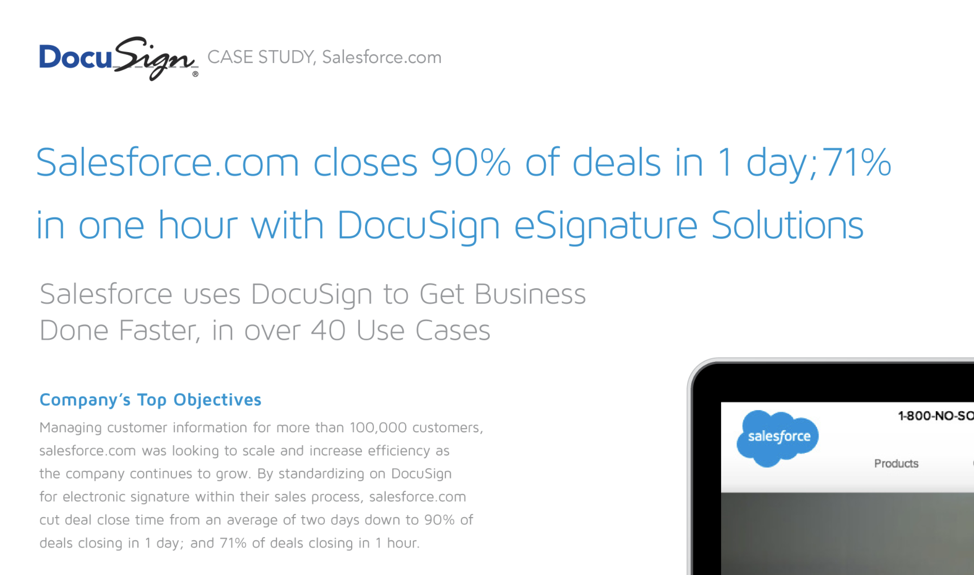
When creating case studies for your freelance business, focus on the results you’ve generated for your clients. What was the problem you helped clients to solve, how did you do it and what was the outcome?
22. Build strategic partnerships
Partnerships come in all shapes and sizes. You could create a piece of content with a partner company, where you both work on an e-book and promote it to each other’s audiences.
Start with relationships where you’ve already established trust. This includes your network and especially your existing clients.
For example, PPC agency KlientBoost partnered with brands like Invoca to create an in-depth guide on remarketing:

Both brands promoted the guide to their audiences, making the most of the trust that they have established.
This is the secret to great partnerships. It’s not just about adding value to brands you want to partner with, but the audience that they’re serving. Figure out what their audience is interested in, and make it a win-win for everyone involved.
23. Contribute to publications with guest posts
Having articles published in relevant, authoritative industry blogs and publications is an effective way to expand your audience.
We’d recommend pitching editors directly with ideas that you can write about based on your expertise. Start your email by sharing previous content you’ve written. Then, ask them if they’re accepting contributions.
Only then should you pitch your article ideas. Look at recently published articles to get an idea of the publication’s style, tone of voice and the formats of content they prefer. It’s important to write content that their audience will find valuable.
Many professionals and freelancers make the mistake of writing an article and then submitting it. The problem is, if it gets rejected, you’ve just wasted your time. Agree on a topic with editors upfront, and then start writing.
Finally, make sure you target blogs and publications with a large audience to make it worth your while. Check out how many followers they have on social media to get a feel for this.
24. Experiment with paid media
If you have the budget, paid media can be a fast way to attract new clients. There are a couple of effective ways you can do this:
- Advertise your services directly, offering a free consultation or “strategy session”
- Offer a lead magnet, such as an e-book or video training, to get people into your sales funnel
The channels you advertise on will depend on your target audience, but you’re likely to have some success with Facebook, Instagram, LinkedIn and Twitter.
These four platforms have an active user base full of your ideal clients, and have powerful targeting features to ensure your message gets in front of them.
25. Use podcasts as a business development tool
Setting up a podcast isn’t just a great way to add value to your audience. It’s also the perfect business development tool to connect with industry thought leaders, as well as senior decision makers and target companies.
Identify the people you wish to connect with and reach out with an offer to interview them. This may take some time to gain traction, but most thought leaders and executives are keen to get their names out in front of a wider audience.
It’s a win-win for your potential clients and audience, as you’ll be putting fresh content out there for them to learn from. As social media expert Ian Anderson Gray of iag.me and Confident Live Marketing Podcast says:
“Getting new clients is important to me, but it’s more specific than that. I want to attract my perfect clients and repel ones that are not a good fit. It’s mainly down to creating highly valuable and in-depth content that will help my perfect client.” – Ian Anderson Gray, Marketing Consultant
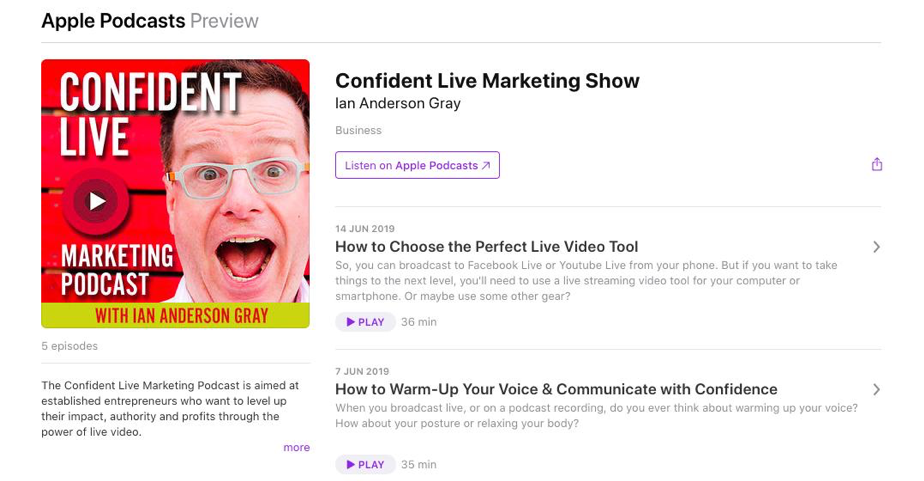
26. Write a book and actively promote it
Writing a book can position you as an authority in your space. As with podcasting, you can use it to connect with thought leaders, journalists and bloggers.
Thanks to services like Amazon’s CreateSpace, self-publishing has never been easier. Write your book, upload it and get samples printed to send to bloggers to review.
You can also send your book in the post to prospective clients as a gift. This helps cut through the noise found in their email inbox (by circumventing it entirely), while providing unique value.
Remember, like with all content marketing efforts, your book needs to be high quality. If you create something that lacks value and doesn’t talk to the needs of your audience, you may end up hurting your reputation instead of elevating it.
27. Get speaking gigs to boost your credibility
Event planners are always on the hunt for good speakers. Start looking for speaking engagements and be prepared to accept unpaid gigs when starting out. Make them an offer with a strong proposal, outlining how you can add value to their event.
Alison Prangnell, a Master NLP Coach and Clinical Hypnotherapist of Anderida Coaching says:
“At speaking engagements or workshops, people get a taste of what you can do, and you get more people talking about you.” – Alison Prangnell, therapist
Introduce yourself to book stores, local libraries and reading groups for book readings. Reading enthusiasts love meeting authors.
28. Create eye-catching business cards for the digital age
We know, business cards can seem outdated. And if you’re purely in the digital space then this might not be for you. But you’d be surprised by how many people still ask for business cards, and you want yours to stand out from the crowd.
Create an eye-catching business card template using online tools like Canva, Vistaprint and MOO. Aim for clarity and uniqueness. Accentuate with colours and images that speak volumes about your freelance services.
This example from Flow Yoga shows how simple, relevant and eye-catching your business cards can be:
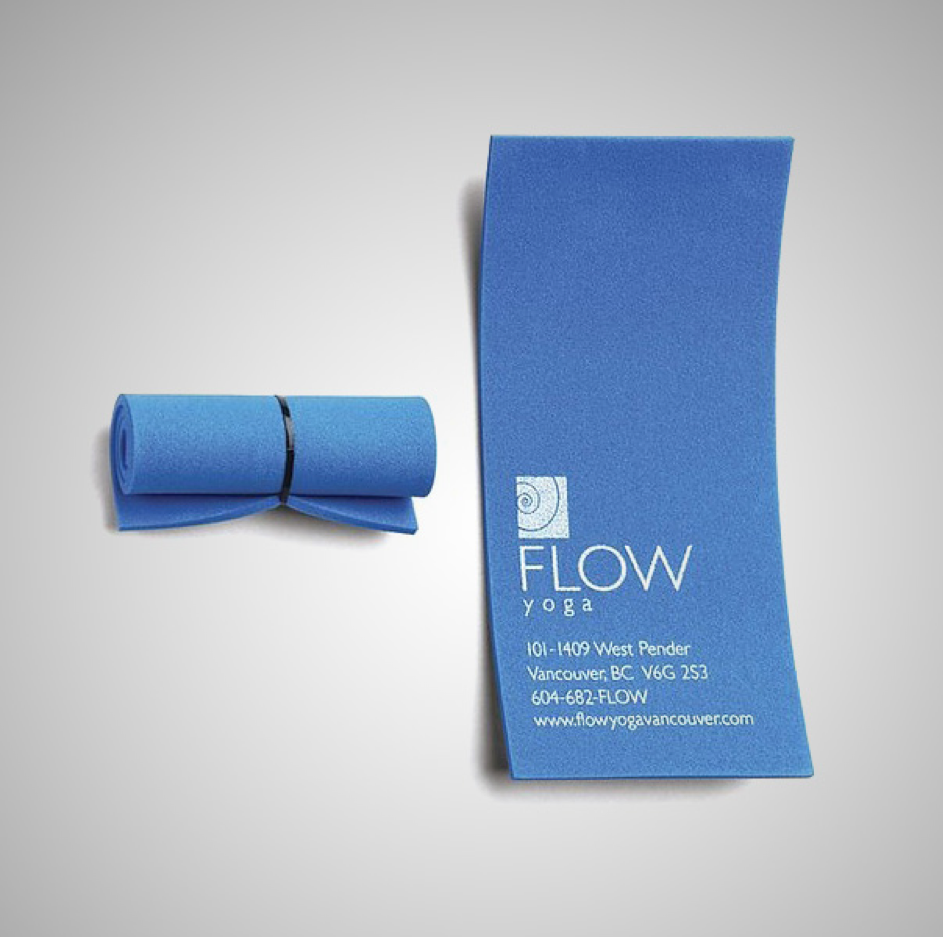
29. Run a PR campaign
You’ve published articles on blogs and magazines. You’ve also created podcasts and YouTube videos. These all count as publicity activities within the realm of digital marketing, but publicity is more than this.
Good PR consists of offline activities, such as community fairs and sponsorships. Consider amplifying your message with well-designed online and offline activities within your budget.
You can also subscribe to HARO, a free network of journalists looking for sources on various topics. Emails are sent on a daily basis and are segmented by various categories. If you spot a journalist asking for information on a topic you have expertise on, reach out and provide it to them.
30. Attend industry conferences
If you’re creating content as part of your freelance business, take advantage of the “press passes” that many conferences offer. Getting behind-the-scenes gives you a great opportunity to connect with big players in your industry.
Most keynote speakers are distinguished individuals, so it is an excellent opportunity to meet them face to face. Offer an interview opportunity to them. Influencers, journalists and bloggers in most industries are keen to reach a new audience, so they’ll most likely take you up on your offer.
While many live events have been disrupted by Covid-19, some conferences and trade shows are continuing as virtual events, which may offer similar opportunities to connect with peers and develop your network.
31. Start a YouTube Channel
You don’t need fancy equipment to start a YouTube channel. In fact, you can film valuable video content with just a smartphone and a tripod. You can generate a lot of attention with a small budget, as long as people care about what you have to say.
Start by talking about topics that provide solutions to specific pain points, or around frequently asked questions you get from clients. Remember to research your audience and clients to identify what these topics are.
Choose a format that works for you. For example, you could repurpose your podcast into a video series to double-down on your efforts, just like Matt D’avella does for his Ground Up Show podcast.
Alternatively, fire up your camera and provide value like you would when writing a blog post. Write a list of points you want to address, sit down in front of the camera, hit record and start talking.
When starting out, the production value of your videos doesn’t matter as long as the content is of high quality. What does matter is the value you share with your audience.
Quick Tip: If you’re looking to boost your video game, check out our complete guide to video marketing and learn how to create and promote high-quality videos.
32. Use search engine optimisation (SEO) to get found online
Your ideal clients are busy looking for a freelancer like you. The key to capturing their business is to be findable. One of the most effective ways to make yourself discoverable, is to ensure that your website is optimised for search engines.
Essentially, this means researching the words that people use to search for someone like you, and then using those words on your website. Of course, SEO gets a little more complex than that, but the key thing is to echo the language that searchers use.
Sounds obvious? Yes, it does. But researching the search terms (keywords) that people use can uncover some surprises — so it’s worth doing some investigating before you build your website around words that most people don’t use.
Search for a ‘free keyword tool’ to start your research.
💡 Expert insights
Insights author: Stuart Allen is the Managing Director of The Sales Performance Company, helping B2B businesses of all sizes to increase sales revenues and margins through a mix of sales consultancy, training and coaching.
What are some client acquisition methods that freelancers often overlook?
When any client acquisition method is overused, it loses its potency. In 2012 when I launched The Sales Performance Company my telephone was rapidly inundated with cold calls trying to sell me everything from advertising to recruitment services. I was getting ten plus calls a day, every day and it was frustrating and annoying. Just eight years later I’m getting just one or two per month!
With an increase in the use of email and social media for business, I’m instead inundated with a daily cascade of (on average) one hundred messages. I read very few of them and block persistent offenders. These methods of client acquisition did work when they were new and novel but now everyone is using them they have become impotent. My advice to freelancers is to do their research on the target prospect and then pick up the phone and call them.
Wrapping up
This guide is designed to act as a hub of ideas to attract new clients. Not all the options we’ve laid out will be right for you, but there should be a handful of techniques that will work again and again.
Remember, growing a business takes commitment and patience. The best way to use this guide is to identify three to five approaches that you feel confident will work. Then, follow this process to execute:
- Find in-depth guides on each topic to learn best practices and techniques
- Search for examples on how others have executed them and gained results
- Create a plan to test these new approaches and select the metrics to measure success
While there are many approaches you can use, not all of them will work for you right away. Experiment with the techniques that are relevant to your business and double down on those that get results.
Learn all about growing your business in our marketing series:
Marketing Strategy
1.1 How to create a ‘Go To Market Strategy’ to tap into new markets
1.2 A beginners guide to digital marketing strategy
1.3 How to run a competitive analysis
1.4 How to build a brand that customers love
Marketing Ideas
2.1 8 affordable in-depth marketing ideas to grow your small business
2.2 30 ways to get clients as a freelancer
2.3 5 marketing metrics to maintain & measure small business growth
Marketing Channels
3.1 How to create a social media marketing strategy in 2020
3.2 The small business guide to Instagram marketing
3.3 How to build brand loyalty with relationship marketing
3.4 How to master business storytelling
3.5 How to grow your business with video (on a budget)
Photo by LinkedIn Sales Navigator, published on Unsplash
Become a Marketing Pro with our guide
As a small business owner, it can be tough getting new customers without breaking the bank.
Download our small business guide to marketing on a budget and learn how to acquire customers and build your business from £0 a month.







